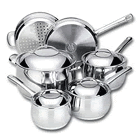
I’ve had a reader request (my first!) to talk about cookware: if buying or replacing, what kind should you choose?
As I see it, the main choices for cookware are
- Teflon/Non-stick
- Stainless steel
- Copper
- Cast iron
- Glass
- Aluminum
I consulted three sources for information on each. My sources were
Sally Fallon
,
Cheryl Mendelson
, and
Ellen Sandbeck
.
Teflon and Non-stickNon-stick cookware is lightweight, non-reactive, often inexpensive and. . . non-stick.
While cheap and convenient, both Sandbeck and Mendelson mention problems with fumes at high temperatures; in fact, Sandbeck notes that “Fumes from overheated Teflon-coated cookware have been known to kill caged birds.”
There are also problems with durability: the non-stick surface chips off or gets scratched rather easily. I agree with Sandbeck, who says, “Eating a little oil is a lot healthier than eating a little Teflon.”
Stainless SteelStainless steel is almost non-reactive (Mendelson reports that if something salty or acidic is stored in stainless steel for a long time, corrosion may occur), can deal with high temperatures, is dishwasher safe, and can be inexpensive.
One of my favorite cooking pots is a stainless steel saucepan that my husband bought from Sears when he was a bachelor immigrant to this country many years ago.
You’ll want your stainless-steel pot to have an aluminum core—it helps in heat transfer.
Fallon urges her readers to choose stainless steel cookware over aluminum because of aluminum’s highly reactive nature. (See below.)
CopperCopper is a good heat conductor, but it needs to have a stainless steel lining since it is very reactive--acidic foods can absorb an unhealthy amount of copper.
Copper is usually more expensive than other options, and it tarnishes—which means you have to polish it regularly.
Cast IronCast iron holds eat well, is virtually indestructible and is inexpensive. But it is also very heavy and should not be used to store food, since food can absorb too much iron.
GlassGlass cookware is non-reactive, good for storage and inexpensive—but more delicate than metal. I once made a hot Pyrex casserole pan explode by attempting to deglaze it with room-temperature wine. Not pretty.
AluminumWhile cheap, lightweight and abundant, aluminum cookware is also very reactive. Salty or acidic sauces will actually pit the surface of an aluminum pot. Cabbage becomes smellier when cooked in aluminum. Have you ever cooked sorrel in an aluminum pot? It turns into a slimy, brown ooze.
Mendelson notes that the FDA finds no evidence of danger in ingesting aluminum and that the link to Alzheimer’s disease posited years ago has been debunked.
Still, Mendelson does not recommend using aluminum pots because of the off-tastes and discoloration in food--and the reality of ingesting more aluminum than our bodies are designed for.
Fallon notes that aluminum is toxic to the body in large quantities and that other facets of modern life—processed soy products, refined table salt, deodorants, antacids—also introduce quantities of aluminum to our systems, so it might be best not to compound this with even more aluminum exposure.
Sandbeck calls aluminum cookware “unsafe at any heat.”
So, given all that, what is the recommendation?Sandbeck uses stainless steel and cast iron cookware.
Fallon uses stainless steel and cast iron cookware.
And so do I.





















